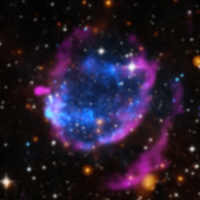 HEAPOW: Bulldozer (2014 Apr 21)
HEAPOW: Bulldozer (2014 Apr 21)
Moving around large pieces of a galaxy is no easy feat. It requires an engine of enormous power, such as a supernova explosion. In a core-collapse supernova, a massive star runs out of nuclear fuel and falls inwards. Energy generated in this collapse results in the destruction of the star and the expulsion of the outer stellar layers at high velocities, producing as much power as generated by all the rest of the stars in the galaxy combined. The ejected material smashes into its surroundings and sweeps them up into a roughly spherical ball. The image above shows an interesting example of this process at work. This image of a supernova remnant in the Milky Way called G352.7-0.1, is a composite of an X-ray image from the Chandra X-ray Observatory (in blue), an optical image (in white), an infrared image (in gold, from the Spitzer Space Telescope) and a radio image in purple (from the Jansky VLA). This multi-wavelength image shows extraordinary details of the interaction of the supernova's powerful shock wave and the surrounding gas and dust in the Galaxy. Observations with Chandra and XMM-Newton show the hottest gas is dominated by the ejecta from the supernova explosion bounded by cooler swept-up material seen in the radio and infrared. Studies show that the amount of swept-up material is enormous, about 45 times the mass of the Sun, and the amount of hot X-ray emitting gas in the interior is about twice the Sun's mass. Given the age of the remnant (about 2200 years), it's a puzzle why the X-ray emission is dominated by the interior ejecta; in other remnants of similar age, X-ray emission is usually dominated by the outer swept-up material. Astronomers are still searching for the remnant of the exploded star's core, which may be a young neutron star or baby black hole.
CXC: G352.7-0.1: Supernova Cleans Up its Surroundings
XMM-Newton and Chandra Observations of the Ejecta-Dominated
Mixed-Morphology Galactic Supernova Remnant G352.7-0.1 - Thomas G. Pannuti et al
- Astrophysical Journal 782(2) 102 (2014 Feb 20) DOI: 10.1088/0004-637X/782/2/102
arXiv.org > astro-ph > arXiv:1401.6603 > 26 Jan 2014
| << Previous HEAPOW | High Energy Astrophysics Picture of the Week | Next HEAPOW >> |